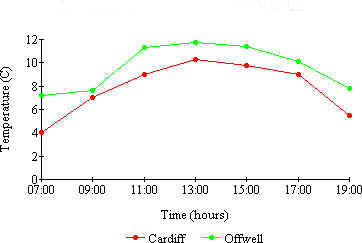
Remote Experiments as a Learning Tool
An Educator's Appraisal

| Taking part in the pilot remote experiment was thoroughly enjoyable and rewarding. To help encourage would-be experimenters, I have outlined below a brief summary of some of the direct educational benefits of participating in remote experiments, and also some of the pitfalls. The level of complexity involved lies with the experimenters, as does the incredible scope for really interesting and worthwhile investigations. |
| Integrated Learning |
The remote experiment provided an excellent opportunity to learn using interesting and imaginative means. The great strength of such an opportunity lies in the integrated approach to multi-disciplinary learning. Many different aspects of learning, not only different subjects, but also styles of learning, can be integrated in one project. The students utilise information and knowledge already gained, and deepen their knowledge in many subjects. They also have the opportunity to acquire a range of practical skills. It is a partnership of academic theory and practical application, where all the skills used (whether they are theoretical or practical) are purposeful, that is for the specific purpose of successfully running the experiment. The multidisciplinary challenge of the project meant that knowledge was used and deepened in many areas, for example: design and technology, geography, science (physics, biology, and environmental science), and information technology. Mathematical skills were required to record data and produce graphs (manually), this included choosing the type of graph, its layout, etc., computer IT skills (both to run and research the experiment), writing skills, and research skills. It provided an excellent avenue for teamwork and problem solving. There were many facets to establishing and running the experiment, a number of which were not immediately obvious, but required working out, and finding solutions to. Each aspect of the experimental procedure required thorough testing. A great deal of initiative and thought was necessary to carry out the project. |
| Inductive Teaching |
| We used an inductive approach to guide the children through the experiment, helping them to come to the decisions that needed to be made. So for example, rather than just using the Met Office website to find out how to construct a weather recording station, we discussed with them the principles involved, and let them make suggestions for themselves, instead of merely copying a prescribed method. This particular approach to learning is imaginative, interesting and rewarding. |
| Involved Students |
| The students can be involved in the experiment and the decisions needed to run the experiment. The depth of involvement can be appropriate to the age/skills of the particular group of students. Our involvement with the project was as a team effort, every member of the group made a very valuable contribution. The children were fully involved at every level, whether it was researching, thinking, discussion, producing the housing, testing out ideas, running trials and carrying out the experiment itself. Many skills were required to run the project. |
| Scientific Methodology |
| Quite apart from the intrinsic scientific value of the experiment, we felt there was also a great deal to be gained from the insight into scientific methodology. There were several really important scientific principles at the heart of the project, namely, (i) careful, accurate observation (both through active experimentation and observing the natural world); (ii) testing quantitatively, not merely subjectively, at every stage of the experiment; (iii) recording the observations precisely; (iv) accounting for these observations; (v) communicating the observations and ideas clearly (both oral and written presentations). |
| Pitfalls |
In a project of this kind, which necessitates bringing together a number of factors, there is the potential for quite a range of complications. Hence, one of the most likely pitfalls is to make the experiment, or experimental procedure, too complicated or ambitious, which increases the capacity for even more difficulties. Although we did not experience this particular problem, I could imagine that it would very easy to do so. The computer is one of the cornerstones of remote experiments, but it can also be the source of major problems (eg, viruses, problems downloading information from the Internet). The time taken to set-up the experiment can be longer than anticipated. We found that even when one has a clear idea of what one wants to achieve or produce, and how to do so, it can take much longer than expected. For example, to test the thermometer housing required certain specific weather conditions, which were not always forthcoming at the required time! It is important to realise that not everything that one tries is going to work, and therefore, not to view a preliminary trial/test as success or failure. It is only from the trials that one learns. We soon realised that it would have been useful to keep a detailed diary of all the tests and trials (results as well as method), including the preliminary ones, as a record of the project; it is something we would recommend to future experimenters. |
| Conclusion |
| Remote experiments hold tremendous potential for groups to participate in scientific projects that would otherwise be impossible for them to do so. Science is essentially a practical discipline, and this presents a marvellous opportunity to take part in a valuable educational project in a most enjoyable way. |
